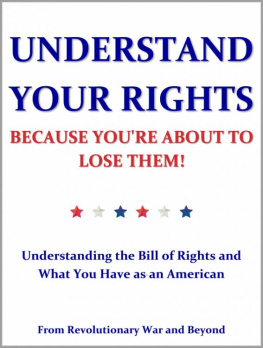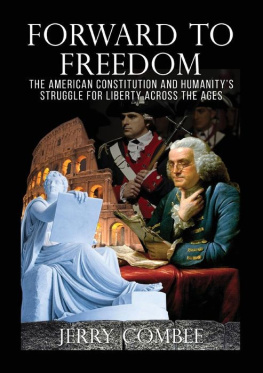
Two Revolutions and the Constitution
Published by Hamilton Books
An imprint of The Rowman & Littlefield Publishing Group, Inc.
4501 Forbes Boulevard, Suite 200, Lanham, Maryland 20706
www.rowman.com
6 Tinworth Street, London SE11 5AL, United Kingdom
Copyright 2021 The Rowman & Littlefield Publishing Group, Inc.
All rights reserved . No part of this book may be reproduced in any form or by any electronic or mechanical means, including information storage and retrieval systems, without written permission from the publisher, except by a reviewer who may quote passages in a review.
British Library Cataloguing in Publication Information Available
Library of Congress Cataloging-in-Publication Data
Library of Congress Control Number: 2021932009
ISBN: 9780761872689 (pbk: alk. paper)
ISBN: 9780761872696 (electronic)
 The paper used in this publication meets the minimum requirements of American National Standard for Information SciencesPermanence of Paper for Printed Library Materials, ANSI/NISO Z39.48-1992.
The paper used in this publication meets the minimum requirements of American National Standard for Information SciencesPermanence of Paper for Printed Library Materials, ANSI/NISO Z39.48-1992.
To Julie
Contents
Guide
For those parts of this book dealing directly with constitutional developments, especially American constitutional developments, I was able to work from copies of the original documents. I am indebted to all the platforms that have made available, online, the primary documents referred to in the Bibliography and Further Reading sections. I must especially acknowledge the outstanding collection of The Avalon Project of the Yale Law School, Lillian Goldman Law Library (in memory of Sol Goldman). I am grateful to the Goldmans and to everyone who has worked on The Avalon Project.
The drafting and implementation of the American Constitution is one of the most important events in the development of the contemporary world because it enabled and propagated republican, constitutional, pluralistic, representative government. The invention of the Constitution has, of course, been written about on many occasions from different perspectives and with a focus on different issues. I am indebted to all the scholars and writers whose work on American topics is referred to in the Bibliography and Further Reading sections of this book.
The English and British have been less interested in their constitution, perhaps, in part, because it is not codified and may therefore seem amorphous. Brexit and the excising of the powers of the European Union from the British constitution provides an opportunity to codify it. That would make its terms more accessible and less uncertain. But it is difficult to see any political dividend for a government that undertook such a project.
My interest in the English revolutionary period was sparked by Geoffrey Robertsons remarkable The Tyrannicide Brief . That book makes a compelling case for the trial and execution of Charles I as a defining event in the development of modern constitutional government (and as a foundation of the modern law of crimes against humanity). I am indebted to all the writers and scholars on English and British topics whose work is referred to in the Bibliography and Further Reading sections of this book.
One person helped me up-close throughout this project: my wife, Julie Claridge. I am grateful to her for her invaluable advice on the manuscript and for her unstinting, generous encouragement and counsel throughout the process of my researching and writing this book.
Several people reviewed a draft of the manuscript or provided me with other helpful comments or assistance. Thank you, Margaret Taylor, Tom Switzer, Simon Bates, Ed Day, Ashish Diwan, Tom Philips, Costas Condo-leon, Andrew Pickford, Charmaine Chow, Greg Lindsay, Lachlan Philips, David Libling, and John M. Green. Mark Malatesta provided valuable guidance on the process of seeking a publisher.
I alone am responsible for any errors.
The American Constitution is Americas fundamental law. Its adoption established a revolutionary new system of government, secured the gains of the American Revolution, and enabled the American nation. It is of daily relevance to Americans because it established Americas current system of government and law.
Why does the Constitution provide for a partly national and partly federal system? Why does it establish three branches of government (Congress, the President, and the Courts) and allocate separate powers to each of them? Why does it check and balance the different branches, including giving Congress the power to impeach? Why does it provide for elections, and for the electoral college?
The answers are found in the history that produced the American Revolution, and in the brilliant adaptations and innovations in the system of government developed by the Framers.
Before the American Revolutionary period, Americans thought that the British constitution was the best in the world. Under the British system and their colonial charters, Americans already enjoyed greater liberties and opportunities than any other people, including those in Britain.
Once they declared independence in 1776, the former British colonies in America needed their own rules for a new system of government. They drafted and adopted State constitutions. They needed co-operation between the States to fight the British, so the new States tried a confederation. It was too weak, so eleven years after declaring independence, the Framers devised a revolutionary federal and national constitutionthe first major written constitution of the modern world.
The new State and federal constitutions and the system of law were deeply influenced by the British system, but with brilliant and revolutionary changes. Americans removed the British monarch and entrenched their freedoms in an innovative scheme that was tyrant-proof and uniquely American. It was built on the sovereignty of the American people rather than the sovereignty of a king or queen.
So, as well as describing the American Revolution and the development of the American constitutions that came before the final Constitution, this book tells the story of the revolutionary development of the English system of law and government that was a foundation of the American system.
Habeas corpus (the right to prevent unlawful or arbitrary imprisonment) began as a power of the king to prevent his subjects being unlawfully detained by local noblemen.
No taxation without representation, the most famous slogan attributed to the Revolutionary period, is a principle that dates back at least to the ancient Magna Carta.
When the English tried and executed their King Charles I, they were insisting that the King was subject to Parliament and to the law. The President is subject to constitutional checks and to law.
When Parliament installed a new King and Queen (William and Mary) to replace the rash James II, it also passed a Bill of Rights entrenching many ancient English liberties. The American Bill of Rights was added to the Constitution almost immediately after it was ratified.
Meanwhile the common lawlaws that had been developed by the people and judges and not handed down by a monarch or legislaturewas imported from England and gradually adapted in America, as a bulwark of protections of individuals and their property.
In the earliest of their new constitutions (which were State constitutions) the Founders opted for frequent elections, strong legislatures, and weak executives. They knew from British history that before the English (or Glorious) Revolution, kings had sometimes delayed elections, convened Parliaments infrequently, and governed with little control by Parliament.
Next page






 The paper used in this publication meets the minimum requirements of American National Standard for Information SciencesPermanence of Paper for Printed Library Materials, ANSI/NISO Z39.48-1992.
The paper used in this publication meets the minimum requirements of American National Standard for Information SciencesPermanence of Paper for Printed Library Materials, ANSI/NISO Z39.48-1992.